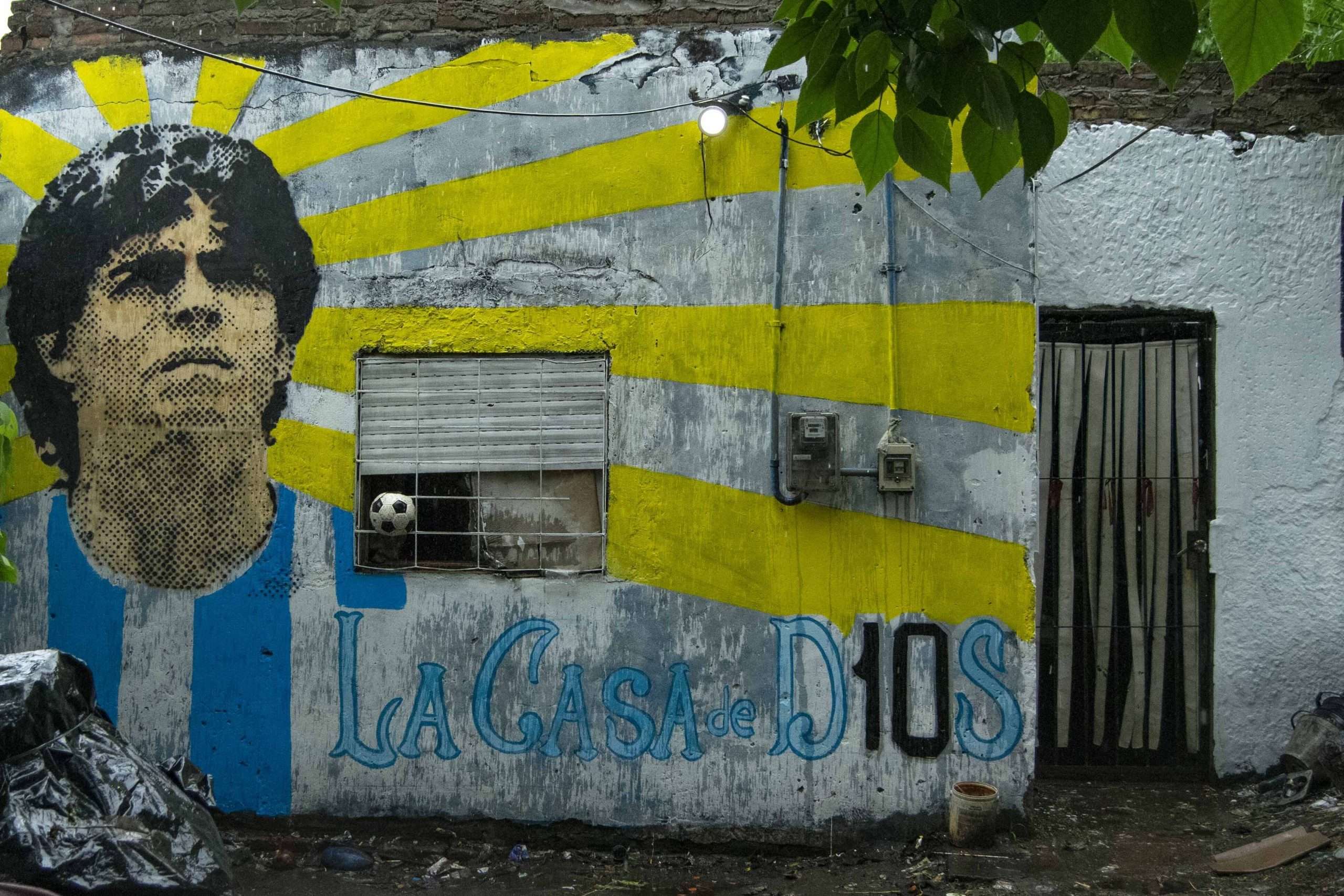This article is a sample of Issue 4 of our The Modern Footballer magazine – get your copy now here!
Every football fan around the world remembers where they were when they heard the tragic news of Diego Maradona’s passing in November 2020. Heading home on a wet evening in Madrid, I didn’t expect my notifications to have a particularly profound impact on me as I found a seat on the metro and turned on my mobile data. Yet there it was: Maradona está muerto. Following a minute of self reflection and processing of the news, I did what any overwhelmed and unsettled person would do by instinct; I looked around my carriage in a silent cry for help.
A quick glance at my fellow passengers, everyone was gazing at their screens, slowly digesting the heart breaking news that filtered in from Argentina. Maradona, arguably one of the greatest players to have played the game was no longer amongst us. One by one, Argentinian flags slowly started appearing on the terraces of homes around the city as expats from the country paid their respects to their national hero, who continues to divide Rioplatenses to this day.
While he was an icon of football, his influence extended well beyond the football pitch. He was raised in an Argentina divided by race and class. While his mother’s ancestors hailed from Italy, his father’s Guaraní background has led him being labelled as ‘negrito’ by his peers, a word often used in Argentina to describe people of indigenous descent who faced marginalisation from mainstream society.
Maradona himself directly experienced this form of social discrimination in his childhood, which manifested itself in abject poverty – he lived with nine family members in a three bedroom shack that had no running water or electricity in the slums of Villa Fiorito on the outskirts of Buenos Aires. His exposure to social ostracisation at such a young age has had a lasting impact on his political outlook and influenced his future activism.
Maradona started his professional career with Argentinos Juniors in 1976, a year that is notorious in Argentina. Following the death of popular left wing president Juan Perón in 1974, the power was handed over to his widow Isabel Martínez de Perón. Dissatisfied with her politics and the continued terrorist acts of Peronist groups such as the Montoneros, the military led a successful coup d’état to overthrow the democratically elected government.
What followed is often described as the darkest period in Argentinian history. Known as el Proceso de Reorganización Nacional (or more colloquially as El Proceso or ‘The Process’), Argentina’s right wing military dictatorship held a firm grip on the country between 1976 and 1983. The regime, which was chiefly presided over by General Commander Jorge Rafael Videla until 1981, propagated the Guerra Sucia (Dirty War) across the country, which led to the disappearance and death of 30,000 people in the space of 7 years – mostly left wing political sympathisers.
Under the military junta the economic situation of the poorest in Argentinian society worsened in a country already rife with social inequality. The promotion of free trade and the deregulation of the Argentinian economy not only led to an increase in debt, but also rapid inflation. Under the dictatorship wages plummeted to levels that were below half of what people earned under Perón’s presidency, with the poorest bearing the brunt of the Argentine Peso’s collapse.
During this difficult period, Maradona’s performances on the pitch offered a glimmer of hope and a distraction for Argentines. El Pibe de Oro (The Golden Boy) was a role model for many fellow Descamisados – a term used to describe Argentina’s working class and supporters of Peronism. He became the primary provider for his family when he signed his professional contract at Argentinos Juniors and grew into an idol for working class citizens across the country who found themselves at the bottom of the hierarchical and oppressive Argentinian society. His performances improved year on year, and in his last two seasons he scored 69 goals in 71 appearances for El Bicho, in addition to providing valuable assists to fellow attacker Pedro Pasculli.
In 1981 Maradona transferred to Boca Juniors – a club which is predominantly supported by the working class population of Buenos Aires. El Diez’s move to a left wing club during El Proceso further increased his popularity amongst Argentines, especially amongst those who had similar background to his and were hit the worst by the dictatorship. La Azul y Oro won the 1981 Primera División title, which ended up being the only Argentinian title Maradona ever won.
Maradona was already a well known sensation in football circles, but his appearance at the 1982 World Cup caught the attention of fans around the world. His performance against Hungary in particular – a side which humbled El Salvador 10-1 in the same tournament – is often regarded as his breakthrough performance on the global stage. However, Argentina failed to impress – internal conflicts between younger and older players within the squad were left unresolved and La Albiceleste were comfortably knocked out in the second round group stage by Brazil and Italy.
After the 1982 World Cup, Maradona decided to stay in Spain, not least because of the political situation in his home country. He signed for Barcelona for a world record fee at the time. An impressive performance in the 1983 Clásico earned him applause from Real Madrid fans, a first in the fixture’s 80 year history.
Despite winning 3 different cups in 1983, Maradona did not fulfil fans’ expectations. He was unable to put a stop to the Basque dominance of La Liga in the early 1980s, during which Real Sociedad and Athletic Bilbao won 2 titles each. Maradona’s time on the Costa Brava was plagued with injuries and he was embroiled in numerous conflicts on the pitch, most notably with Miguel Sola, who insulted his indigenous ancestry.
The lack of support for El Diez after this incident showed the profound differences between Barcelona Football Club as a community and Maradona as a Descamisado; Barcelona has always been the club of the city’s Catalan bourgeoisie – the elite and most wealthy of Spanish society – meaning he was unable to win the hearts and minds of supporters and the board. Maradona needed a club where he was welcome and amongst those who celebrated him for the values he stands for.
When Maradona penned a deal to play for Napoli, a new era had begun in not just the club’s history, but Italian club football as a whole. Fans around the world were left looking bewildered as the best player on the planet signed for a team that nearly got relegated the previous season and had never won the league. However, looking at the economic and socio-political context of contemporary Italy, the move made perfect sense.
Neapolitans’ feeling of bitterness towards the North had been brewing since the 19th century, when Garibaldi conquered the former Capital of the Two Sicilies during the Italian War of Unification. The South of Italy is traditionally the poorer half of the peninsula, as the major industries and manufacturing centres were located in regions such as Piedmont and Lombardy. While in the 1980s the Italian economy was booming – even overtaking the UK economy (il sorpasso) – that growth disproportionately benefited the northern provinces.
The predominantly working class population in the south experienced high levels of unemployment and economic hardship. These difficult times allowed football to become a way of life. Throughout his time at Gli Azzurri, Maradona felt a sense of responsibility to bring joy to those people who felt oppressed by the elite of society. On the football pitch, El Diez led Napoli to two Serie A titles (1987 and 1990) and a UEFA Cup (1989), the only league and European titles that the club have held. Where football plays such a big part in people’s lives, it came as no surprise that Maradona acquired near divine status.
Would have he been adored the same way in any other major club in Europe? Perhaps not. Maradona’s and Napoletani’s common struggle for working class recognition allowed mutual understanding between player and club, enabling El Pibe de Oro to freely express himself on and off the pitch without facing the censorship that pursued him during the Argentinian dictatorship and at Barcelona.

While his achievements at Napoli cannot be celebrated enough, it was his performances at the 1986 World Cup that defined him and confirmed Maradona’s sacred status in Argentina. It would become the most significant tournament that Argentina have participated in given the country’s contemporary political and societal context.
In the early 1980s the military junta faced a number of challenges. The economy was worsening year on year and the Argentinian working classes increasingly became dissatisfied with the regime’s inability to lead effectively. In order to distract citizens from Argentina’s dire situation and to unite the country under a common patriotic cause, the dictatorship diverted attention to the contentious status of the Falkland Islands. The 10 week long unsuccessful conflict against the United Kingdom – a war which was never declared officially by either side – left 649 Argentines dead and rising anti-government sentiment in the country.
The dictatorship eventually ended with the election of Raúl Alfonsín from the left wing Unión Cívica Radical party in 1983. In conjunction with the changing political landscape, the 1986 World Cup was an opportunity to make a statement on the global stage; this was a new Argentina, ready to put behind its sombre past and open up to the world.
Considered to be the best footballer at the time, Maradona acted as a de facto diplomat to the new regime. Even today, Argentines hold the 1986 World Cup title in much higher regard than the one they won in 1978. Following the end of the Guerra Sucia, Argentines found solace in their success and could freely celebrate their triumph. The 1978 World Cup, which they won on home soil, never felt as though it belonged to them. The World Cup was just one of the propaganda tools the dictatorship used to indoctrinate Argentines and it was overshadowed by the countless disappearances that were taking place at the time.
Despite the initial optimism, Alfonsín was never able to fulfil expectations. His attempt to increase wages to pre-dictatorship levels inadvertently led to further inflation. In a desperate attempt to reform the economy in 1987, the government turned to the World Bank, which subjected Argentina to a series of IMP structural adjustment programs. In turn, this encouraged the privatisation of public services and fiscal austerity, depriving the working class from affordable services such as water and electricity and a reliable welfare state.
Facing increased disapproval from the general population and opposition parties, 1989 saw the country elect Carlos Menem from the centre right group Partido Justicialista. Even though they promised to revert Alfonsín’s economic strategy during the campaign, they chose to build upon it once in power. Their liberal right wing stance on the economy led to hyperinflation and market oriented economic policies, increasing social inequality and pushing the poorest of Argentinian society further into outright poverty.
During this period, Maradona, an outspoken socialist, became an embodiment of not just working class movements in his home country, but around the world. He became a cultural icon and the subject of artistic expression. A song titled ‘La Vida Tombola’ dedicated to El Diez by Manu Chao, a popular musician in the Spanish speaking world, one example.
Post-retirement, Maradona chose to surround himself with left wing Latin American politicians such as Evo Morales, Hugo Chávez and Fidel Castro. He was often seen spending time with the latter, smoking cigars on his yacht and playing football in his garden. In one of El Pibe Oro’s most iconic pictures after his retirement, he’s shown proudly exposing his Che Guevara tattoo to the Cuban president. The image’s profound meaning cannot be overlooked – two of the most emblematic Argentines in the 20th century on one body. It was rather fitting that Maradona died on the same day as Fidel Castro, November 25th, four years later. A coincidence? Who knows.
Despite his contentious reputation, Maradona will forever remain an icon for millions of football fans around the world and a symbol for global working class struggle. His status in society can be best described by the words of great Argentine writer Jorge Luis Borges: Enamorarse es crear una religión cuyo Dios es fallible (To fall in love is to create a religion whose God is fallible). For many, Maradona was this God. ¡Hasta Siempre El Diez!
–
Tom Cserép is a freelance writer and photographer based in Madrid and London focusing on European football, culture and the environment.










